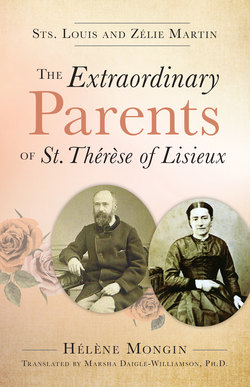Читать книгу The Extraordinary Parents of St. Thérèse of Lisieux - Helene Mongin - Страница 9
На сайте Литреса книга снята с продажи.
ОглавлениеIntroduction
The canonization of Louis and Zélie is a historic event because, for the first time in its history, the Church is canonizing a married couple together. And not just any couple. They are the parents of Thérèse of the Child Jesus, “the greatest saint in modern times,” according to Pope Pius XI.
Louis and Zélie have not been canonized because of their daughter, however. She, of course, revealed their faces to her readers. And in other respects this saying of Christ—“you will know them by their fruits” (see Mt 7:17-20)—can be applied to Thérèse and her parents, but her role ends there. It is the very holiness of Louis and Zélie themselves that the Church is recognizing in their prophetic holiness. Their example shows us in fact that holiness, far from being an ideal reserved for elite souls, consecrated souls, or martyrs, is a choice and a grace offered to everyone.
And so the Church wants to highlight a holy family in our age and offer a hopeful response to violent attacks on the nuclear family today.
Louis and Zélie, despite the century that separates us, had lives that are surprisingly similar to those of our contemporaries. Both of them were working while they raised their children, they were always busy, they knew the joys and sorrows of ordinary families, and they died of illnesses that are familiar to us: breast cancer for Zélie and arteriosclerosis for Louis, an illness that affected his brain and put him in a psychiatric hospital for three years. The holiness of the Martin spouses doesn’t come from any events themselves but from the manner in which they lived. In every aspect of their lives they had only one source and one goal: God’s love. This heart orientation, far from making them unearthly, made their ordinary lives an adventure of love in which they raised up their family, their neighbors, their friends, their employees, and even the whole Church.
I hope that the reader will share the joy I had in studying the lives of Louis and Zélie. In doing so, I made use of several documents that I recommend to those who wish to know more about the Martin couple:
— Correspondance familiale (1863-1885), [Family Correspondence from 1863 to 1885] (Paris: Éditions du Cerf, 2004), which contains 217 letters from Zélie, most of which were sent to her brother and sister-in-law in Lisieux from 1863 until her death in 1877. She is the family letter writer since Louis didn’t like to write. All through this period, it’s not surprising that she takes center stage in the story since the sources for her are much more abundant. These lively letters, written in a spirit of freedom and humor, allow us to know Zélie and her family intimately. In that same book there are fifteen letters by Louis, most of them written after the death of his wife, which show him to be a tender man of depth focused on God.
— Histoire d’une famille [The Story of a Family], by Father Stéphane-Joseph Piat, O.F.M. (1946; repr. ed., Paris: Téqui, 1997). This is the authorized biography of the family; daughter Céline Martin stated everything in it was true. It first appeared in 1946, so it’s written in a bit of an outdated style, but it’s complete and well documented.
— Zélie Martin and Louis Martin, by Dr. Robert Cadéot (François-Xavier de Guibert, 1996), two excellent biographies based on the testimony of Céline about her parents and on excellent historical research. Unfortunately, both are currently out of print.
— Zélie et Louis Martin, les saints de l’escalier, by Henri and Alice Quantin (Ed. du Cerf, 2004). Without agreeing with all of their analyses, I have to thank them for the brilliant way in which they demonstrated the incoherence of the base accusations made against Louis and Zélie by authors who do not deserve to be mentioned. This allowed me not to have deal with the same painful polemic.
— La mère de sainte Thérèse de l’Enfant-Jésus and Le père de sainte Thérèse de l’Enfant-Jésus, both written by Céline Martin (Carmel of Lisieux, 1953-1954).
— Les Oeuvres complètes (Ed. du Cerf, 1992), by Thérèse de l’Enfant-Jésus, which is still the best source about Louis.
— Numerous editions of Thérèse de Lisieux and of Vie thérésienne, well-documented journals published by the Pèlerinage Sainte Thérèse de Lisieux.
— The website www.archives-carmel-lisieux.fr is a gold mine for photos, texts, and documents on Thérèse, and also on her whole family.
We could summarize the history that follows according to what we hear in fairy tales: “They lived happily and had many children”—but they did so in the shadow of the cross. And now we enter intimately into a very real and engaging family to see the faces of Louis and Zélie, so human but holy.
